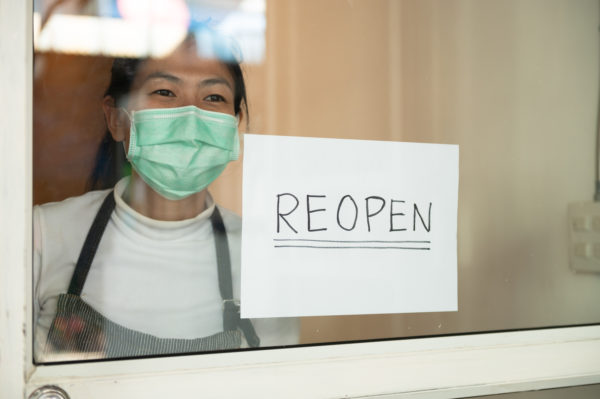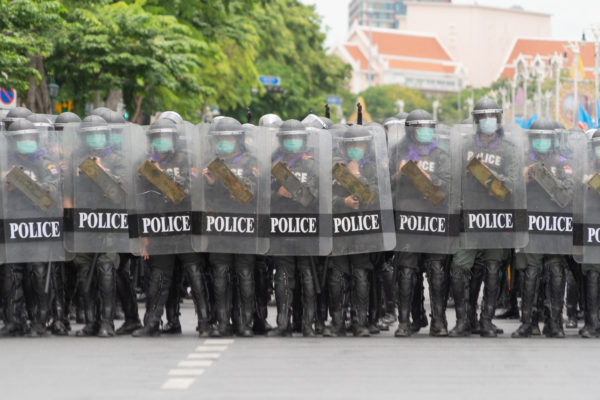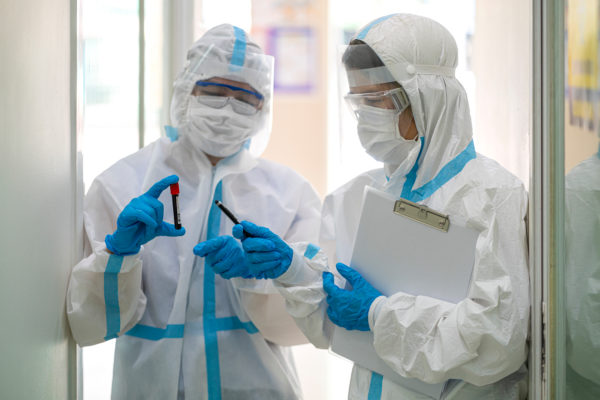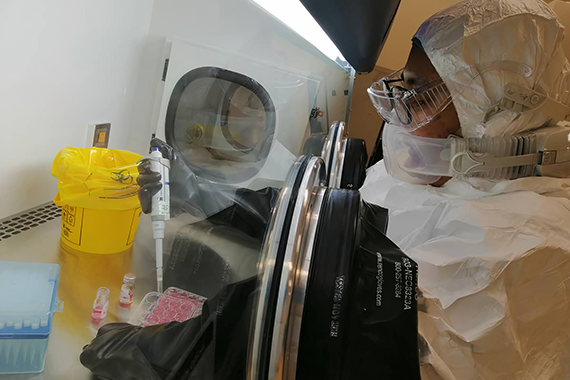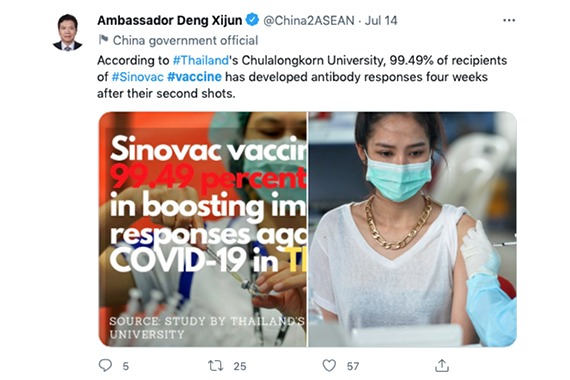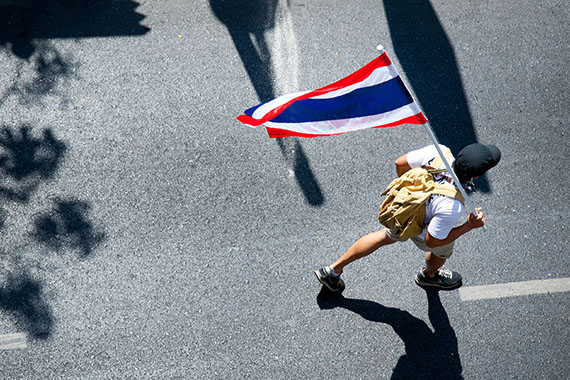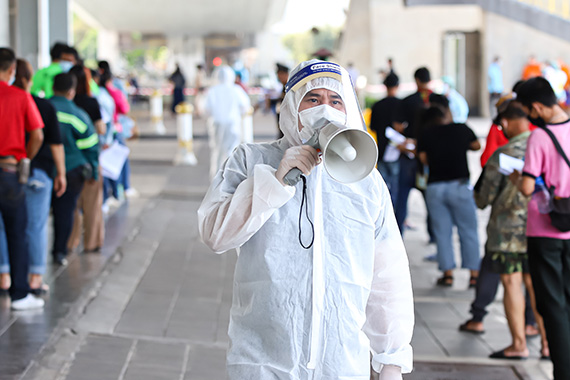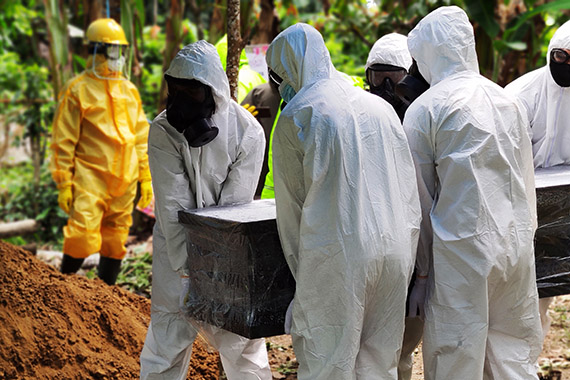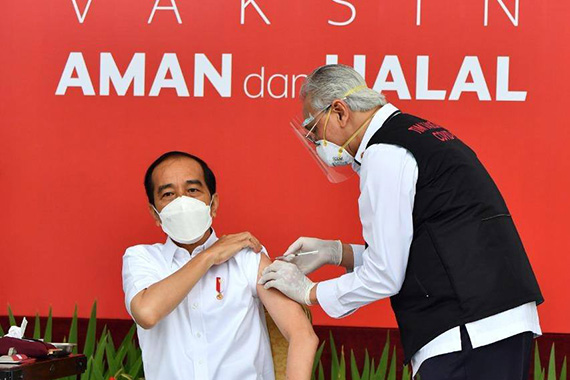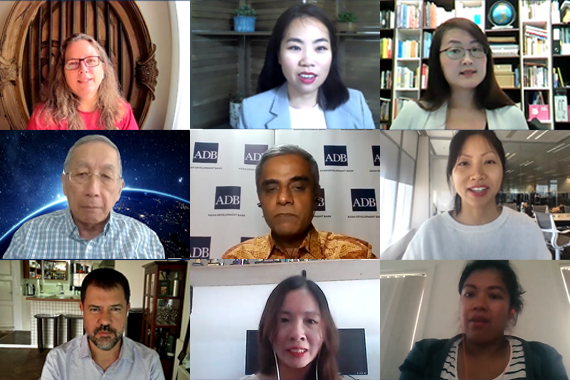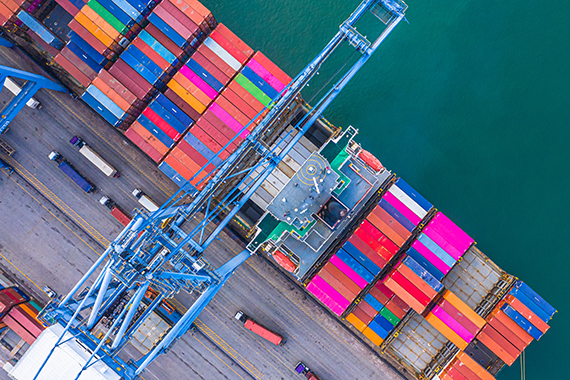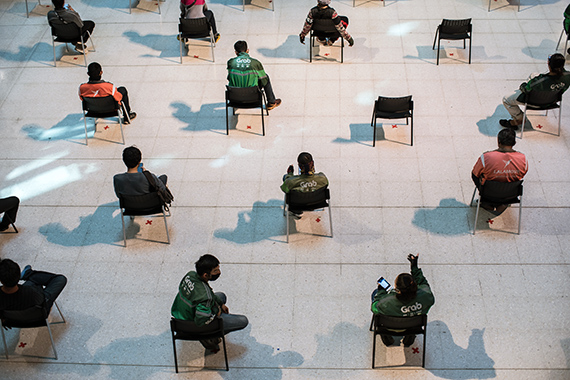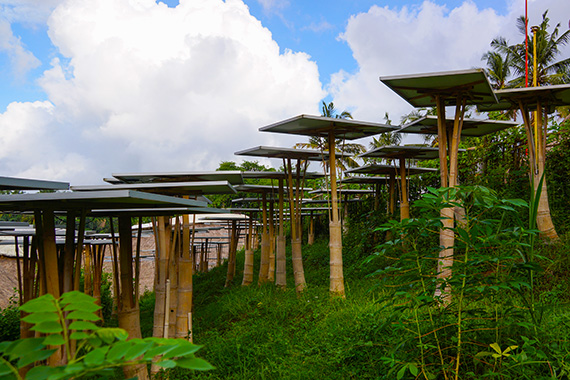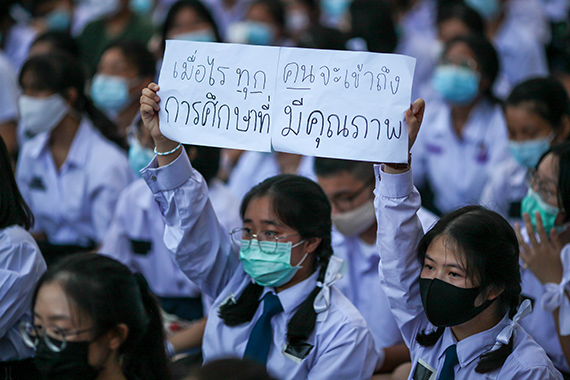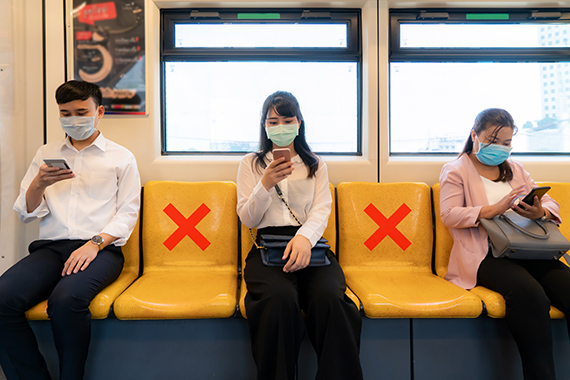Strange Bedfellows: Crisis and Opportunity in ASEAN
By Sharon Li-Lian Seah
Published on 10th February 2021
Read in 9 minutes
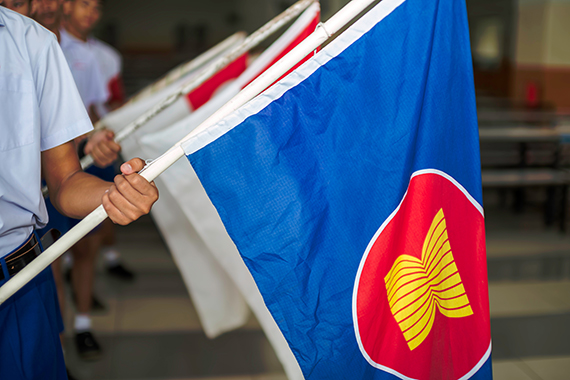
ASEAN flags – BeanRibbon – Shutterstock
Aptly termed ‘the crisis of a generation’, the COVID-19 pandemic was a perfect storm waiting to happen – presenting a confluence of danger to human health and well-being, and to economic survival.
Yet this crisis also presents an opportunity for a hard reset, for change, and for innovation. This pandemic has yet to come to its end, with many countries currently experiencing subsequent waves of infection. The emergence of a new and more virulent strain may pose fresh challenges.
Still, a year since the world went into lockdown is as good a time as any to assess and review the performance of the Association of Southeast Asian Nations (ASEAN) as the pandemic gripped the countries of this economically and strategically vital region.
Skip to section:
Was there an ASEAN response to speak of? How realistic are ASEAN’s plans? Post-COVID economic recovery Out of crisis, an opportunity? Interview About the AuthorWas there an ASEAN response to speak of?
ASEAN is often derided for delivering more pomp and ceremony than substance. In 2020, though, the group surprised observers by approving some 80 documents and agreements, the highest number ever in a given year.
With national borders shut and travel effectively out of the question, ASEAN moved its meetings online, like everyone else. The annual ASEAN calendar typically consists of over 1,500 meetings, but about 230 meetings were scuttled.
ASEAN managed to convene most of its meetings online, doing away with much of the ceremony and using a new format of raising agenda items in plenary, in effect reducing the number of opportunities to caucus. In turn, there was a greater number of agenda items passed in omnibus.
Despite the numerous disruptions brought on by the global pandemic, ASEAN had a productive year. ASEAN was able to achieve several early outcomes targeted at immediate pandemic health response and recovery cooperation, such as the establishment of a special COVID-19 ASEAN Response Fund for immediate healthcare needs, and an ASEAN Regional Reserve of Medical Supplies for Public Health Emergencies (created in April 2020 for strategic stockpiling purposes).
Later in the year, ASEAN agreed to set up an ASEAN Centre for Public Health Emergencies and Emerging Diseases, akin to a regional centre for disease control and prevention (CDC) of sorts, along with an ASEAN Comprehensive Recovery Framework and Implementation Plan to aid regional countries in a post-COVID-19 economy recovery.
When the first case of COVID-19 was reported by Thailand in January 2020, ASEAN was criticised for failing to take proactive action.
Individual countries made national decisions on whether to impose travel restrictions, conduct mass testing, or simply close their borders, depending on the virus’ patterns of transmission, local diagnostic capabilities and hospital and medical capacities.
Some countries went so far as to impose export bans on certain agri-food and medical items to maintain enough supplies for their own populace. A state-led response, made in the interests of domestic constituents, was to be expected. In fact, all eyes were on Wuhan, China which was at the centre and, many believed, to be the origin of the epidemic. How China responded was going to affect how the rest of the world reacted.
Despite the absence of regional coordination, ASEAN was not caught completely off-guard as it was able to utilise mechanisms that had been set up in response to earlier public health emergencies, such as the 2001 SARS outbreak.
Some of these mechanisms include the ASEAN Emergency Operations Centre Network (EOC Network) for public health emergencies and the ASEAN plus Three Field Epidemiology Training Network, which worked well in disseminating information and coordinated operational work.
ASEAN received early cooperation from China in late January 2020, when daily situation updates and response measures were shared with the ASEAN Plus Three countries through the two established networks. To be fair to ASEAN, the World Health Organization’s (WHO) delay in declaring the pandemic a Public Health Emergency of International Concern (PHEIC) caused much confusion and resulted in countries’ inability to seek assistance internationally.
How realistic are ASEAN’s plans?
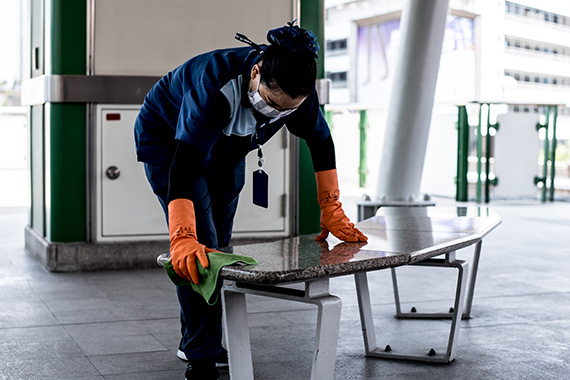
Bangkok Transit Service Cleaner – UN WomenPloy Phutpheng – Flickr
Much of what ASEAN has initiated and pledged would not have been possible without financial support and technical assistance from ASEAN Dialogue Partners. In April 2020, Australia, New Zealand, China, Japan and the Republic of Korea (ROK) pledged $US1 million each to the special COVID-19 ASEAN Response Fund (CARF). Within ASEAN, better prepared countries like Vietnam, Thailand and Singapore also pledged to the CARF.
At the ASEAN-related Summits in November 2020, the Republic of Korea pledged $US5m to assist ASEAN countries to improve virus detection capacities. Japan offered $US200m in grant assistance for medical supplies and equipment, $US2.5b in COVID support loans, and an additional $US50m from the Japan-ASEAN Integration Fund to support the establishment of the ASEAN CDC.
Australia pledged $A550 million to assist Southeast Asia in COVID recovery, including $A21m to the ASEAN Centre for Public Health Emergencies and Emerging Diseases to facilitate vaccine access. The United States pledged a relatively modest $US87m to assist ASEAN in implementing the various initiatives to combat the virus.
All things given, ASEAN countries have managed the pandemic relatively better than other regions, with countries like Vietnam and Thailand instituting early lockdown and social distancing measures. But ASEAN’s lead may diminish in the coming year if social controls turn lax due to complacency.
It is early days yet to assess whether ASEAN’s COVID-19 recovery plans will be fully implemented, let alone be effective. Pledges are one thing, the will to implement and actual implementation is another. Vietnam has led the call for a collective, regional approach to mass vaccination. This led to a decision made in the ASEAN Ministerial Meeting on January 21 to utilise the COVID-19 ASEAN Response Fund to procure vaccines, even though this provision was already present in the original Terms of Reference.
Similarly, after many months of discussion, the opening of an ASEAN travel corridor to facilitate essential and business travel between ASEAN member states has yet to come to fruition due to difficulties in harmonising travel protocols, mass testing and quarantine requirements and the complication of new and subsequent waves of infection.
The emergence of new and more virulent strains of the virus from the United Kingdom and South Africa will complicate matters further. Indonesia has been appointed by the ASEAN Foreign Ministers to lead the ASEAN Travel Corridor Arrangement Task Force. Indonesia’s Foreign Minister Retno Marsudi has promised that work will be completed by the first quarter of 2021.
Post-COVID economic recovery
ASEAN regionalism is at its best within the ASEAN Economic Community. ASEAN may agree to disagree when it comes to thorny political issues like the South China Sea but where economic issues are concerned, there are no questions about keeping trade and investment life lines free and open for ASEAN’s own survival.
Within the first few months of lockdown, ASEAN member states were already thinking of what a post-COVID recovery would look like and what measures could be instituted to pull the region out of a COVID-induced recession. The first steps were to ensure that trade flows remained unimpeded and to turn back the dial on any form of economic nationalism.
This included an early agreement among the ASEAN Economic Ministers to keep markets open for trade and investment, strengthen long-term supply chain sustainability, aid companies to digitalise, remove trade barriers and build on existing trade facilitation platforms such as the ASEAN Single Window to facilitate trade flows. Similarly, the Agriculture and Forestry sector also pledged to keep trade lines open for agri-food products.
ASEAN lost no time in finalising the Regional Comprehensive Economic Partnership (RCEP) trade deal with five Dialogue Partners – Australia, New Zealand, China, Japan and the ROK.
Despite COVID-19, the final RCEP negotiations were concluded and the agreement signed in mid-November 2020.
India decided to stay out, although special provisions have left the door open for its membership at some future point. India’s participation would have given a geo-political balance in the trade agreement and opened new trade opportunities, but differences seemed insurmountable. An early ratification with at least 6 ASEAN signatories and 3 non-ASEAN signatories in 2021 will most definitely guarantee ASEAN a much-needed economic boost.
Beyond pushing back on economic nationalistic sentiments, ASEAN rolled out a suite of initiatives to increase trade facilitation and accelerate digitalisation. The operationalisation of the ASEAN Single Window (ASW) was finally completed in 2020, as part of ASEAN’s trade facilitation plans, with all 10 ASEAN member states on board to improve trade competitiveness through the electronic exchange of cross-border trade documents.
Although established in 2005, there was no real impetus to fully operationalise the ASEAN Single Window until COVID-19 limited trade exchanges that needed physical contact. ASEAN understood how the ASW could alleviate the burdens on the regional supply chain by effectively digitalising trade facilitation. It will be opportune now to extend the ASW to Dialogue Partners to increase external trade flows in the immediate term.
The ASEAN-wide Self-Certification scheme, a deliverable announced two years ago, also commenced in September 2020 to help ASEAN exporters reduce costs and time. It will also improve domestic trade regulatory performance. In addition, the ASEAN Customs Transit System (ACTS) was implemented in early December 2020 to help companies export seamlessly within the region. Expedited customs clearance will reduce time and costs in intra-regional trade in goods. This can only mean potential benefits for the region as a whole.
Besides trade, ASEAN accelerated the drive towards a digital transformation in other sectors, such as tourism. The ASEAN Declaration on Digital Tourism was adopted at the 37th ASEAN Summit to revive Southeast Asia’s vital tourism industry, on which many ASEAN members states rely economically.
The Declaration pledged cooperation to develop new digital platforms, digital database systems and encourage ASEAN micro, small and medium enterprises (MSMEs) to adopt digital technologies in order to facilitate seamless travel experiences using contactless immigration procedures, digital payment modes and contact tracing applications under crisis conditions.
ASEAN was fortuitous to have enjoyed the past few years of economic integration work relatively uninterrupted. Countries have been quietly working to get their companies and economies on the digital highway, for example by integrating their National Single Windows with the ASEAN Single Window. The signing of the RCEP was also possible because negotiators spent eight long years together in face-to-face meetings and discussions.
Discussions on a possible ASEAN-EU free trade agreement (FTA) are in the works. However, it will be very difficult to conclude another new FTA soon, political will notwithstanding, if the COVID-19 situation remains protracted. These negotiations take time and require discussions that simply cannot be done entirely online. Realistically, what ASEAN can aim for are possible upgrades to several existing agreements such as the ASEAN-China FTA and ASEAN-Australia-New Zealand FTA to add new provisions such as e-commerce and digital trade to aid in economic recovery and resilience.
Out of crisis, an opportunity?
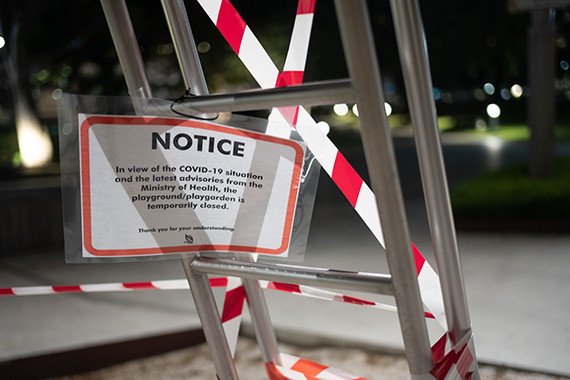
Singapore Circuit Breaker – Foam – Flickr
All things given, ASEAN’s pandemic scorecard is quite nearly top-of-class. It has performed relatively better than other regions in terms of getting its infection case and death loads down. It is also relatively efficient in securing vaccine access, although admittedly the jury is still out whether it is wise to rush into untested vaccine territory.
ASEAN has stayed the course on its economic integration work despite the challenges posed by COVID-19. In fact, COVID-19 may fundamentally re-shape ASEAN’s understanding of what economic integration looks like. Digitalisation may well prove to be the new driver of effective economic integration.
Southeast Asia has been seized for most of the year with battling COVID-19 outbreaks and recession concerns. Although these issues took up much of ASEAN’s mind space in 2020, other long-standing political-security issues, as well as new and emerging concerns, such as the potential for a flareup in the South China Sea, major power rivalries, the upholding of the rule of law, peaceful settlement of disputes, green recovery and climate change will continue to feature on the ASEAN agenda in 2021.
There is now the opportunity for ASEAN to demonstrate regional leadership by tapping its convening powers to corral support from its Dialogue Partners to prioritise some issues over others, such as ensuring greater transparency in the negotiations for a Code of Conduct in the South China Sea. This would assure interested parties that any outcome would not be at the expense of others.
ASEAN should also make clear its concern that major power rivalry is not conducive to the effective functioning of global architecture, reiterate the importance of the rule of law and take the green recovery route, instead of going back to a business-as-usual model. These are all opportunities for ASEAN to demonstrate its value to the global multilateral order in this time of crisis.
Interview
About the Author
Ms Sharon Seah is Coordinator at the ASEAN Studies Centre and Coordinator of the Climate Change in Southeast Asia Programme at the ISEAS – Yusof Ishak Institute. Prior to joining the ISEAS – Yusof Ishak Institute, Ms Seah was Associate Director of the NUS Centre for International Law. She has spent 14 years in the National Environment Agency and Ministry of Foreign Affairs prior to entering academia, including a diplomatic posting to the Singapore Embassy in Bangkok, Thailand from 2003 to 2007. Ms Seah maintains an interest in climate change and environmental issues; multilateralism and ASEAN development. Ms Seah graduated with a Master in Public and International Law from the University of Melbourne in 2018. She co-edited 50 Years of ASEAN and Singapore (World Scientific: 2017) with Professor Tommy Koh and Ms Chang Li Lin. She also edited Building a New Legal Order for the Oceans (NUS Press: 2019).
